Nature Conservation 2025 — 31. 7. 2025 — Focusing on the Public — Print article in pdf
The Hodonínská Dúbrava/Hodonín Oak Grove House of Nature
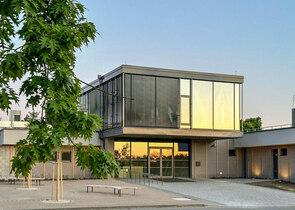
‘Pannonian oak forest on sand’. This is a title of a unique habitat of open-canopy/coppice oak groves that have been preserved north of the town of Hodonín (South Moravia) covering some hundreds of hectares. Extraordinary geological conditions and centuries of using them by humans resulted in remarkable species diversity. Rather paradoxically, species that elsewhere occur in steppes and meadows are the main target of nature protection, conservation and management there.
Today, the stands are a Site of European Importance (SEI, pursuant to Act No. 114/1992 on Nature Conservation and Landscape Protection, as amended later, the term for Site of Community Importance, SCI, later Special Area of Conservation, SAC, under the European Union’s Habitats Directive) within the European Union’s Natura 2000 network, and the most valuable parts have been protected as a National Nature Monument since 2014. If you want to know more about this remarkable natural gem, you have the opportunity as of June 1, 2024: on that day, the Hodonínská Dúbrava/Hodonín Oak Grove House of Nature was launched in the town of Hodonín, being the only visitor centre in the Czech Republic dedicated to a small-size Specially Protected Area.
Its initiator was the Municipality of Hodonín in collaboration with the Nature Conservation Agency of the Czech Republic (NCA) and Moravské naftové doly//Moravian Oil Mines company, which is also significantly involved in other regional, i.e. South Moravian projects related to landscape and environmental protection.
The exposition also presents the nature of two different and very significant habitats in the surrounding of the Hodonínská Dúbrava/Hodonín Oak Grove, namely an aeolian/wind-blown sand community in the Pánov Nature Monument at the eastern margin of the forest complex and a fishpond system on the Kyjovka stream, bordering Dúbrava on the west.
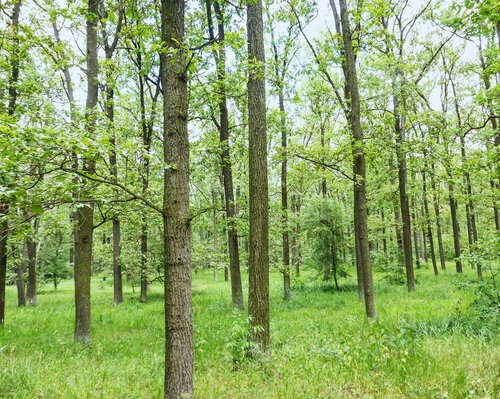
Pannonian oak forest on sand is a unique habitat occurring in the Czech Republic only north of the town of Hodonín. © Libor Ambrozek
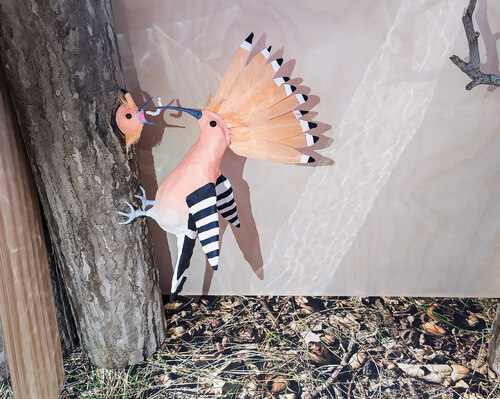
One of the twenty infoboxes introduces us to a Eurasian hoopoe feeding its young. © Petra Kotásková
A forest as many others,
a visitor to Hodonínská Dúbrava/Hodonín Oak Grove may say at a glance. But a first impression can easily deceive. The central theme of the exposition, designed by architects Roman Strnad, Jan Vrbka, and Jiří Jurenka of TheBüro studio, is therefore looking into depth. The principle is a play with an escalation of scales – the actual forest almost starts behind the premises of the building, while the upstairs extension itself, in which the exhibition is located, is a model of a forest. The construction is made of wood, and the load-bearing elements are conceived as trees with branches. The very imaginative solution was designed by the Létající inženýři studio headed by architect Tomáš Havlíček.
Walking through this miniature forest, one encounters another miniature, a model of a forest named Modeles, the heart of the exposition as a whole. Visitors can look into the model by means of a camera obscura, where the model is moved by projected thematic animation. All key features and activities one can encounter in the area are presented within six square metres. The core of the model includes open coppice oak forests and former human activities to which the forest owes its species diversity, i.e. mowing and grazing. We further see oak forests encroached by a shrub layer and pine monocultures, the result of intensive forest management in the 20th century, which has displayed a significant negative impact on the current state of the Dúbrava. Also captured is the interesting history of the Pánov: pasture in the Middle Ages, later becoming a military training area where after World War II, dragoons were replaced by tanks and armoured personnel carriers. Still today, military vehicles have been an important means of maintaining sand steppes with their unique flora and fauna there. In front of us, human activities come to life by three cameras pointed at key Modeles locations. On the infopanel lining the entire display, visitors can learn more about the history, present and extraordinary natural richness of the Hodonínská Dúbrava/Hodonín Oak Grove.
What else can be found upstairs?
When a visitor explores Modeles, (s)he will not know what to do first. The whole space is filled with a range of original exhibits with even more original titles. These definitely win on the count of Infokrab items, twenty in number! They are based on the principle of surprise: the content is hidden (although the rhyme on the outside gives a little hint), so if interested, you have to open them. In 15 cases, you will find the most important plants and animals, portrayed by artists Vendula Chalánková and Hana Svobodová. You can also look forward to photographs and short video sequences, and on the inside of the lid you will learn many interesting facts about the species in question. The remaining five infoboxes deal with significant features, presented by one-minute videos. Opening them not only reveals the content, but also triggers a variety of nature sounds.
Equally important as the iconic species is the explanation of the wider context, the links between them, and a presentation of the whole ecosystem. The individual exhibits are therefore thematically linked and complement each other.
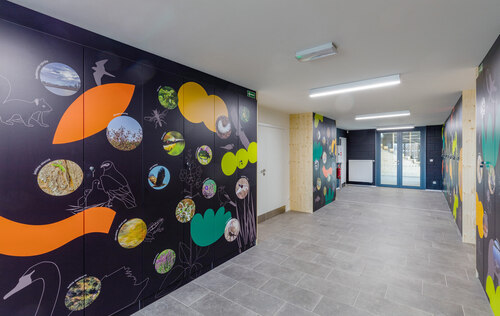
Visitors find dozens of colourful photos of wild plants and animals on the doors in the cloakroom.
© Aleš Ležatka
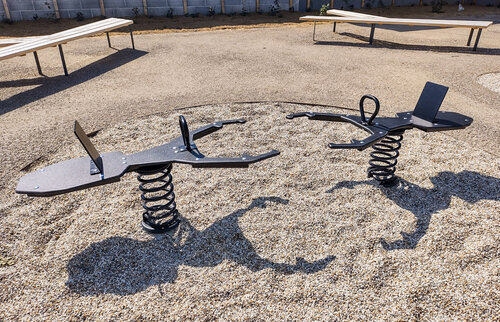
In front of the building, you are welcomed by two fighting males of the stag beetle, mascot of the House of Nature, as a seesaw for small children. © Petra Kotásková
Mr Oak in the main role
As indicated by the term House of Nature, the cornerstone of the community is the oak. In our case it is the Pedunculate oak (Quercus robur), symbol of power, longevity, and resistance, a sacred tree for many peoples since ancient times. Several exhibits are dedicated to it, trying to capture its role in all aspects. Stromostroj, portrayed by Jiří Vítek, is a foldable model of a tree which visitors can take apart or put together. It is accompanied by a text about tree anatomy as well as its nutrient cycle and production. Dřevořez is found somewhat hidden behind Obrazobot, a large projection screen. Although the name is singular, visitors see four cuts through oak trunks. The oldest one of them was determined by dendrochronologist Jiří Kyncl to be 284 years old! Its long life was only ended by the 2021tornado. Interesting dates from regional and world history, and from the history of natural sciences are marked on it. The other cuts show changes in natural conditions during tree growth and other facts which can be read from the annual rings.
The Slido exhibit consists of three sliding shiftable panels presenting the rich community of mostly animals which find shelter or food in the tree or live there permanently, and their relationships. The fourth representation of the oak tree, this time as three parts of a trunk in different stages of decay is named Kmenokuk and reveals the colourful world of insects. Over twenty species are shown there, not only in photographs with captions on the infopanel, but also as products of nature located on the trunks.
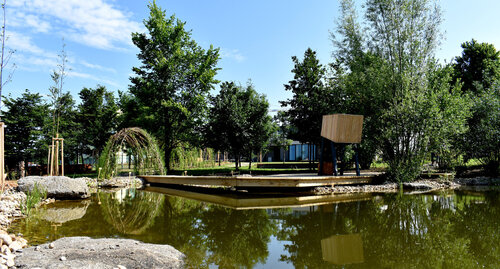
In addition to local herbs, shrubs and trees, the garden also features a sand dune and a waterbody, resembling sand steppes and fishponds. © Petra Kotásková
Sands and fishponds
As mentioned in the introduction, the House of Nature is not only dedicated to coppice oak forests, but also to rather opposite habitats, i.e. aeolian/wind-blown sands and fishponds. Whereas the rolling plains of Pánov refer in summer to the Moravian Sahara, as the nearby Bzenec area was called until the 19th century, the thirty fishponds on both banks of the Kyjovka stream provide a refuge to dozens of waterfowl species. Over the staircase, a graphic design of flying birds named Ptakolet, also created by Jiří Vítek, reminds us of flocks of black-headed gulls (Chroicocephalus ridibundus) and greylag geese (Anser anser). The landscape of sands and fishponds including their plants and animals is captured in a black-and-white image on twee large glass panels connected to the staircase wall. All species are provided with captions as well as colour photos on the infopanel beneath the panels. Boxes with screens inside directed at the glass offer a view of the landscape, play footage from both worlds, and entice to visit them in person.
For playful and competitive visitors
If you feel that you already know much about the nature of Hodonínská Dúbrava/Hodonín Oak Grove and its surroundings, you can test your knowledge in a quiz which runs on a large screen poetically named Obrazobot. The quiz has three levels, so if you are not certain, you can start with the easiest one. Obrazobot also allows visitors to virtually travel to a variety of locations within the area and become part of a photo of some of them. Children and playful adults may prefer the Pexebox, a memory game on two game boards with various numbers of squares. And thirdly, there is a Biotéka for particularly curious visitors. This offers nearly 200(!) wooden cards, which are a really rich mix of information, interesting facts, and photographs of species and phenomena. On the upper side you will find a fact, a question, or the name of a feature or species, while the backside provides answers, photographs, or explanations.
And then the roof
It would be a pity to show plants in photos or videos only. The forest species of the Dúbrava, which we will see in a moment, naturally need shade. However, the inhabitants of the Pánov former military training area ground, which are accustomed to hot sand and lack of water, could get used to growing on the roof. Therefore, strips along the railing have been planted with thirty species which one can encounter on warm slopes or grow on the aeolian/wind-blown sands of southern Moravia – the Hairy feather-grass (Stipa capillata), the Sandy everlasting (Helichrysum arenarium), the Purple mullein (Verbascum phoeniceum), just one beauty after another. The remaining part of the roof is covered with colourful mats of several stonecrops (Sedum spp.) species.
Return to the ground floor
Due to the exhibits, we have started our virtual tour of the House of Nature upstairs. It is now the right moment to return to the ground floor. Situated at the entrance you will find the reception desk, where you can buy, besides tickets, a small souvenir or regional delicacy. Any waiting is made pleasant by two screens where one can view photos of not only Dúbrava, but also other Houses of Nature in the Czech Republic, activities of the NCA CR, or do the quiz that you know from the upstairs. The lobby will delight all map lovers. Inherent to the Houses of Nature are films about the territory of their name. The 20-minute film of the beauty of and threats to the Hodonínská Dúbrava/Hodonín Oak Grove was made by GNOMON Production and is screened in the large hall, also downstairs. In other rooms, children can find a suitable space for environmental education and join various group activities. They will certainly enjoy the time spent there, because such colourful cabinets with dozens of photos of flowers and animals are perhaps nowhere else to be seen.
What awaits us outside outdoor
What would a House of Nature be without a piece of real nature? The road to that was however not easy. Originally, this place was the premises of the Centre for Environmental Education Dúbrava, around which children could use the extensive garden with many valuable full-grown trees, flowerbeds and uncommon secluded places. All this changed at the end of June in 2021, when a devastating tornado swept right through it. Almost nothing remained there. On the contrary, besides fallen trees and debris of the facilities, the wind also brought a lot of other waste. At the same time, however, space for a new garden in the spirit of the presented area was created there.
The exterior exposition was designed by experienced garden architect Lukáš Lattenberg of Atelier Per Partes, while the realisation was undertaken by Florstyl. Again. Visitors find there a small Hodonínská Dúbrava/Hodonín Oak Grove. The House of Nature is lined by beds of common and rare herbs, and new forest and fruit trees as well as a number of shrub species were planted. A stone-lined pond simulates the Kyjovka fishponds, while the Pánov plain is imitated by a quite large sand dune, which certainly be appreciated by children. At both the pond and the dune, infoboxes are located, and there also is an insect hotel in the garden.
Further an outdoor classroom for approx. 40 people, a fireplace with seating, and an open area for games and other events are available there.
|
INVESTOR: Municipality of Hodonín House of Nature architectural design: Létající inženýři studio – Tomáš Havlíček Exposition project: TheBüro studio – Roman Strnad, Jan Vrbka & Jiří Jurenka Garden project: Létající inženýři studio – Tomáš Havlíček in collaboration with Per Partes studio – Lukáš Lattenberg Building contractor: OHLA ŽS, plc. Exposition contractor: Nowatron Elektronik, spol.Ltd. Garden contractor: FLORSTYL Ltd.
TOTAL EXPENSES (incl. VAT): CZK 109.2 million (EUR 4.4 million) Construction costs: CZK 67.4 million (EUR 2.7 million) Costs of interior: CZK 2.1 million (EUR 84,000) Costs of exposition: CZK 17.3 million (EUR 696,000) Costs of garden: CZK 12.2 million (EUR 490,000) Other costs: CZK 10.2 million (EUR 410,000)
TOTAL SUBSIDY: CZK 50,369,301 (EUR 2,027,000) Grant providers: Karel Komárek Family Foundation: CZK 15 million (EUR 604,000) South Moravian Region: CZK 10 million (EUR 402,000) National Programme Environment (energy savings): CZK 2.1 million (EUR 85,000) National Programme Environment (garden): CZK 7 million (EUR 282,000) CONSTRUCTION PERIOD: February 2022 – October 2023 REALISATION OF GARDEN: December 2023 – May 2023 |
Not to forget
Finally, two important issues should be mentioned. Firstly, we are indebted to all those who participated in implementing this large and demanding avtivity. Unfortunately, they cannot all be listed, but some have been mentioned in the text, others can be found in the infobox. Concerning finances, which always come first, the total expense exceeded CZK 100 million (EUR 4 million). While a half of the amount was acquired from some projects, the other half is the Municipality’s contribution. Key donors were the Ministry of the Environment of the Czech Republic (through the Operation Programme Environment funded from the EU funds and other subvention programmes/subsidy schemes), the Karel Komárek Family Foundation, and the South Moravian Region.
Project preparation was completed in 2020, and the actual construction built by the OHLA ŽS company started in February 2022. The exhibition was installed by the Nowatron Elektronik company.
Secondly, we should mention the possibilities, which open up around the new House of Nature. Practically from its entrance, visitors can make a walk to the groves at the National Nature Monument following the red markers. Moreover, adjacent to the nearby Hodonín Zoo, the southern part of the Dúbrava forest complex is available as a suburban forest park – an extraordinary space where inhabitants of and visitors to the town of Hodonín can explore and recreate. It combines natural values, sports and leisure elements. After the tornado raged through part of it, nature is searching its own way of recovery and restoration there, and the town has also been preparing an interesting nature educational trail.
Let us wish the House of Nature and its staff success in bringing the people closer to the beauty of the local nature and in gaining their support for its protection. ■
- - - -
Cover photo: Original wooden structure reminding a forest, hidden behind the blinds on the second floor of the Hodonínská Dúbrava/Hodonín Oak Grove House of Nature. © Petra Kotásková
- - - -

